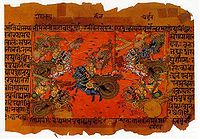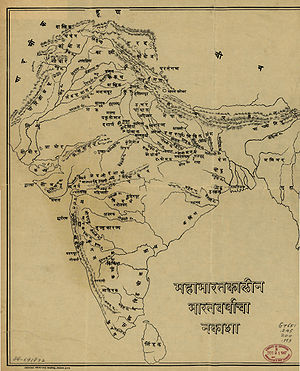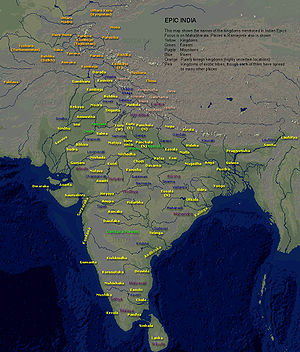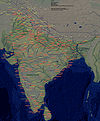
China of Mahabharata
Encyclopedia

China
Chinese civilization may refer to:* China for more general discussion of the country.* Chinese culture* Greater China, the transnational community of ethnic Chinese.* History of China* Sinosphere, the area historically affected by Chinese culture...
people who lived across the Himalayas
Himalayas
The Himalaya Range or Himalaya Mountains Sanskrit: Devanagari: हिमालय, literally "abode of snow"), usually called the Himalayas or Himalaya for short, is a mountain range in Asia, separating the Indian subcontinent from the Tibetan Plateau...
north of India
History of India
The history of India begins with evidence of human activity of Homo sapiens as long as 75,000 years ago, or with earlier hominids including Homo erectus from about 500,000 years ago. The Indus Valley Civilization, which spread and flourished in the northwestern part of the Indian subcontinent from...
in the first millennium BC
1st millennium BC
The 1st millennium BC encompasses the Iron Age and sees the rise of many successive empires, and spanned from 1000 BC to 1 BC.The Neo-Assyrian Empire, followed by the Achaemenids. In Greece, Classical Antiquity begins with the colonization of Magna Graecia and peaks with the rise of Hellenism. The...
or even earlier, and were mentioned in the ancient Indian epic
Indian epic poetry
Indian epic poetry is the epic poetry written in the Indian subcontinent, traditionally called Kavya . The Ramayana and Mahabharata, originally composed in Sanskrit and translated thereafter into many other Indian languages, are some of the oldest surviving epic poems on earth and form part of...
Mahabharata
Mahabharata
The Mahabharata is one of the two major Sanskrit epics of ancient India and Nepal, the other being the Ramayana. The epic is part of itihasa....
. This was the earliest reference to the word "China
China
Chinese civilization may refer to:* China for more general discussion of the country.* Chinese culture* Greater China, the transnational community of ethnic Chinese.* History of China* Sinosphere, the area historically affected by Chinese culture...
", which may have been referring to either the Qin
Qin (state)
The State of Qin was a Chinese feudal state that existed during the Spring and Autumn and Warring States Periods of Chinese history...
state which later became the Qin Dynasty
Qin Dynasty
The Qin Dynasty was the first imperial dynasty of China, lasting from 221 to 207 BC. The Qin state derived its name from its heartland of Qin, in modern-day Shaanxi. The strength of the Qin state was greatly increased by the legalist reforms of Shang Yang in the 4th century BC, during the Warring...
, or a Chinese
Han Chinese
Han Chinese are an ethnic group native to China and are the largest single ethnic group in the world.Han Chinese constitute about 92% of the population of the People's Republic of China , 98% of the population of the Republic of China , 78% of the population of Singapore, and about 20% of the...
tribe that inhabited the Tibet
Tibet
Tibet is a plateau region in Asia, north-east of the Himalayas. It is the traditional homeland of the Tibetan people as well as some other ethnic groups such as Monpas, Qiang, and Lhobas, and is now also inhabited by considerable numbers of Han and Hui people...
region.
Chinas along with other tribes

Mahabharata, Book 6, chapter 9(MBh.6.9) mentions like this:- Among the tribes of the north are the Mleccha
Mleccha
Mleccha , also spelt as Mlechchha, people of foreign extraction in ancient India. Mleccha was used by the Aryans much as the ancient Greeks used barbaros, originally to indicate the uncouth and incomprehensible speech of foreigners and then extended to their unfamiliar behaviour...
s, and the Kruras, the Yavanas
Yavana Kingdom
Yavana or Yona is grouped under western countries along with Sindhu, Madra, Kekeya, Gandhara and Kamboja as per the descriptions in the epic Mahabharata. In later history, this word was used to indicate the Greeks and the Arabs, leading to much confusion....
, the Chinas
Chinas
The Chinas or Chīnaḥ are a people mentioned in ancient Indian literature from the first millennium BC, such as the Mahabharata, Laws of Manu, as well the Puranic literature...
, the Kamvojas, the Darunas, and many Mleccha tribes; the Sukritvahas, the Kulatthas, the Hunas
Huna Kingdom
Hunas were a Chinese tribe close to Himalayas that, because of limited interaction with Indian kingdoms, were mentioned in the epic Mahabharata. They belonged to the Xingjiang province of China, east of Jammu-Kashmir...
, and the Parasikas; the Ramanas, and the Dasamalikas.
Chinas were mentioned along with Chivukas and Pulindas
Himalaya Kingdom
Himalaya kingdom was a mountainous country in Himalayas mentioned in the Puranas. Himavan was probably its ruler and Parvati the wife of lord Siva was probably a princess from this kingdom...
and Khasas
Khasa Kingdom
Khasas were a north western tribe mentioned in the epic Mahabharata. They were probably the modern day Kazakhs found predominantly in Kazakhstan a Central Asian Republic. It is not clear if the Khasas mentioned in Mahabharata were a migrant group from Khasakhstan or original Khasakhs...
, Hunas
Huna Kingdom
Hunas were a Chinese tribe close to Himalayas that, because of limited interaction with Indian kingdoms, were mentioned in the epic Mahabharata. They belonged to the Xingjiang province of China, east of Jammu-Kashmir...
, Pahlavas
Pahlava Kingdom
Pahlava Kingdom is identified to be a kingdom of an Iranian tribe. The kingdom was well known, even during the campaign of Alexander. It was also mentioned in the epic Mahabharata.- Yudhisthira's Rajasuya :...
, Sakas
Saka Kingdom
Sakas were a Mlechcha tribe grouped along with the Yavanas, Tusharas and Barbaras. They were later known as Scythians. They were Soma drinkers, Soma being an intoxicating liquor famous in the land of Devas . There were a group of Sakas called Apa Sakas meaning water dwelling Sakas, probably living...
, Yavanas
Yavana Kingdom
Yavana or Yona is grouped under western countries along with Sindhu, Madra, Kekeya, Gandhara and Kamboja as per the descriptions in the epic Mahabharata. In later history, this word was used to indicate the Greeks and the Arabs, leading to much confusion....
, Savaras, Paundras
Pundra Kingdom
Pundra was an eastern kingdom located in West Bengal, Bangladesh and Purnia . A Pundra king challenged Vasudeva Krishna by imitating his attributes. He called himself Paundraka Vasudeva. He was later killed by Vasudeva Krishna in a battle...
, Kiratas
Kirata Kingdom
Kirata Kingdom in Sanskrit literature and Hindu mythology refers to any kingdom of the Kirata people, who were dwellers mostly in the Himalayas and North-East India. They took part in the Kurukshetra War along with Parvatas and other Himalayan tribes...
, Kanchis
Kanchi Kingdom
Kanchi was a southern kingdom mentioned in the epic Mahabharata. This kingdom took part in the Kurukshetra War. It was considered as one among the Mlechcha kingdoms, that follows non Vedic practices.It is identified as the Kanchi city in Tamil Nadu....
, Dravidas
Dravida Kingdom
During the time of Mahabharata Dravida was mentioned as one among the kingdoms ruled by non-Vedic tribes, in southern India. Its territories include the southern part of modern day Andhra Pradesh and the northern part of Tamil Nadu...
, Sinhalas
Sinhala Kingdom
Sinhala was a kingdom in the island Lanka, modern day Sri Lanka, mentioned in the epic Mahabharata. From 'Sinhala Diva' are derived the Tamil 'Eelam', Persian/Arabic Serendipor Sarandib, and the European 'Ceilao', 'Zeylan' and 'Ceylon'....
and Keralas
Kerala Kingdom
This article is about the Kingdom of Kerala in Indian epic literature. For the present-day region, see Kerala, For the historical kingdom, see Chera dynasty...
. All these tribes were described as Mlechha tribes. Here they were described as the protectors of sage Vasistha
Vasistha
Vashist in the seventh, i.e the present Manvantara, and the Rajpurohit / Rajguru of the Suryavansha or Solar Dynasty. He was the mānasaputra of Brahma. He had in his possession the divine cow Kamadhenu, and Nandini her child, who could grant anything to their owners...
and his cow against the attack of king Viswamitra
Viswamitra
Brahmarshi Vishvamitra is one of the most venerated rishis or sages of ancient times in India. He is also credited as the author of most of Mandala 3 of the Rigveda, including the Gayatri Mantra. The Puranas mention that only 24 rishis since antiquity have understood the whole meaning of, and...
. (1,177)
Pahlavas
Pahlava Kingdom
Pahlava Kingdom is identified to be a kingdom of an Iranian tribe. The kingdom was well known, even during the campaign of Alexander. It was also mentioned in the epic Mahabharata.- Yudhisthira's Rajasuya :...
and the Daradas
Darada Kingdom
Daradas were a people who lived north to the Kashmir valley. This kingdom is identified to be the Gilgit region in Kashmir along the river Sindhu or Indus. They are often spoken along with the Kambojas...
and the various tribes of the Kiratas
Kirata Kingdom
Kirata Kingdom in Sanskrit literature and Hindu mythology refers to any kingdom of the Kirata people, who were dwellers mostly in the Himalayas and North-East India. They took part in the Kurukshetra War along with Parvatas and other Himalayan tribes...
and Yavanas
Yavana Kingdom
Yavana or Yona is grouped under western countries along with Sindhu, Madra, Kekeya, Gandhara and Kamboja as per the descriptions in the epic Mahabharata. In later history, this word was used to indicate the Greeks and the Arabs, leading to much confusion....
and Sakas
Saka Kingdom
Sakas were a Mlechcha tribe grouped along with the Yavanas, Tusharas and Barbaras. They were later known as Scythians. They were Soma drinkers, Soma being an intoxicating liquor famous in the land of Devas . There were a group of Sakas called Apa Sakas meaning water dwelling Sakas, probably living...
and the Harahunas
Hara Huna Kingdom
Hara-Hunas were a Chinese tribe close to Himalayas so that they had limited interaction with Indian kingdoms, thus they were mentioned in the epic Mahabharata.They belonged to the Xinjiang province of China, east of Kashmir...
and Chinas and Tukharas
Tushara Kingdom
Tusharas were a Mleccha tribe, with their kingdom located in the north west of India as per the epic Mahabharata. An account in Mahabharata depicts Mlechchas as the descendants of Anu, one of the cursed sons of king Yayati. Yayati's eldest son Yadu, gave rise to the Yadavas and youngest son Puru...
and the Sindhavas
Sindhu Kingdom
Sindhu&sandhu was a kingdom mentioned in the epic Mahabharata. It stretched along the banks of river Sindhu in the Ancient Greater India, which is now Pakistan. It is believed that Sindhu kingdom was founded by Vrsadarbh, one of sons of Sivi...
and the Jagudas and the Ramathas and the Mundas and the inhabitants of the kingdom of women and the Tanganas and the Kekayas
Kekeya Kingdom
Kekeya is a kingdom grouped among the western kingdoms in the epic Mahabharata. The epic Ramayana also mentions Kekeya as a western kingdom. One of the wives of Dasaratha, the king of Kosala and father of Raghava Rama, was from Kekeya kingdom and was known as Kaikeyi...
and the Malavas
Malava Kingdom
Malava kingdom was one among the many kingdoms ruled by the Yadava kings in the central and western India, corresponding to the Malwa region. Sometimes Avanti and Malava were described to be the same country. They were originally a western tribe, in Punjab province of Pakistan. Later they migrated...
and the inhabitants of Kasmira
Kasmira Kingdom
Kasmira was a kingdom identified as the Kashmir Valley along the Jhelum River of the modern Jammu and Kashmir state. Possibly, the sage Kashyapa or a descendant of this sage lived here, since the name Kas is derived from the name Kashyapa like the name Caspian of the Caspian Sea. During the epic...
were mentioned at (3,51) as bringing tribute to Pandava
Pandava
In the Hindu epic Mahābhārata, the Pandava are the five acknowledged sons of Pandu , by his two wives Kunti and Madri. Their names are Yudhisthira, Bhima, Arjuna, Nakula and Sahadeva. Although, Karna is told by Lord Krishna that according to the laws and ethics he is the first son of Kunti making...
king Yudhisthira
Yudhisthira
In the great Hindu epic Mahabharata, Yudhisthira , the eldest son of King Pandu and Queen Kunti, was king of Indraprastha and later of Hastinapura. He was the leader of the Pandava side in the Kurukshetra War...
.

Yavana Kingdom
Yavana or Yona is grouped under western countries along with Sindhu, Madra, Kekeya, Gandhara and Kamboja as per the descriptions in the epic Mahabharata. In later history, this word was used to indicate the Greeks and the Arabs, leading to much confusion....
, the Kiratas
Kirata Kingdom
Kirata Kingdom in Sanskrit literature and Hindu mythology refers to any kingdom of the Kirata people, who were dwellers mostly in the Himalayas and North-East India. They took part in the Kurukshetra War along with Parvatas and other Himalayan tribes...
, the Gandharvas
Gandharva Kingdom
Gandharva Kingdom refers to the territory inhabited by a people called the Gandharvas, who were one of the Exotic Tribes of Ancient India. They were well versed in music and dance. Gandarvas were also powerful warriors who roamed in Indian kingdoms disregarding any Indian king or Kshatriya warrior...
, the Chinas, the Savaras, the Barbaras, the Sakas
Saka Kingdom
Sakas were a Mlechcha tribe grouped along with the Yavanas, Tusharas and Barbaras. They were later known as Scythians. They were Soma drinkers, Soma being an intoxicating liquor famous in the land of Devas . There were a group of Sakas called Apa Sakas meaning water dwelling Sakas, probably living...
, the Tusharas
Tushara Kingdom
Tusharas were a Mleccha tribe, with their kingdom located in the north west of India as per the epic Mahabharata. An account in Mahabharata depicts Mlechchas as the descendants of Anu, one of the cursed sons of king Yayati. Yayati's eldest son Yadu, gave rise to the Yadavas and youngest son Puru...
, the Kankas, the Pathavas, the Andhras
Andhra Kingdom
Andhra in Indian epic literature was a kingdom mentioned in the epic Mahabharata. It was a southern kingdom. Andhra and Kalinga are often used interchangeably. Andhras are sub-tribes of Andhra satavahanas. The state Andhra Pradesh got its name from this kingdom.Andhra Tribes are also mentioned in...
, the Madrakas
Madra Kingdom
Madra Kingdom was a kingdom grouped among the western kingdoms in the epic Mahabharata. Its capital was Sagala, modern Sialkot . The Kuru king Pandu's second wife was from Madra kingdom and was called Madri. The Pandava twins, Nakula and Sahadeva, were her sons. Madri's brother Shalya was the king...
, the Paundras
Pundra Kingdom
Pundra was an eastern kingdom located in West Bengal, Bangladesh and Purnia . A Pundra king challenged Vasudeva Krishna by imitating his attributes. He called himself Paundraka Vasudeva. He was later killed by Vasudeva Krishna in a battle...
, the Pulindas
Himalaya Kingdom
Himalaya kingdom was a mountainous country in Himalayas mentioned in the Puranas. Himavan was probably its ruler and Parvati the wife of lord Siva was probably a princess from this kingdom...
, the Ramathas, the Kamvojas were mentioned together as tribes beyond the kingdoms of Aryavarta
Aryavarta
Āryāvarta is a name for Northern India in classical Sanskrit literature. The Manu Smriti gives the name to "the tract between the Himalaya and the Vindhya ranges, from the eastern to the Western Sea"....
. The Aryavarta kings had doubts on dealing with them. (12,64)
Pandava's travels
China is mentioned in the travel-descriptions of the Pandavas. The passage below, describes these Chinas, to be located somewhere in the high HimalayasHimalayas
The Himalaya Range or Himalaya Mountains Sanskrit: Devanagari: हिमालय, literally "abode of snow"), usually called the Himalayas or Himalaya for short, is a mountain range in Asia, separating the Indian subcontinent from the Tibetan Plateau...
:

Uttarakhand
Uttarakhand , formerly Uttaranchal, is a state in the northern part of India. It is often referred to as the Land of Gods due to the many holy Hindu temples and cities found throughout the state, some of which are among Hinduism's most spiritual and auspicious places of pilgrimage and worship...
) and crossing the difficult Himalayan
Himalaya Kingdom
Himalaya kingdom was a mountainous country in Himalayas mentioned in the Puranas. Himavan was probably its ruler and Parvati the wife of lord Siva was probably a princess from this kingdom...
regions, and leaving behind them, the countries of China
China of Mahabharata
China in the Mahābhārata refers to an ancient Chinese people who lived across the Himalayas north of India in the first millennium BC or even earlier, and were mentioned in the ancient Indian epic Mahabharata...
, Tukhara
Tushara Kingdom
Tusharas were a Mleccha tribe, with their kingdom located in the north west of India as per the epic Mahabharata. An account in Mahabharata depicts Mlechchas as the descendants of Anu, one of the cursed sons of king Yayati. Yayati's eldest son Yadu, gave rise to the Yadavas and youngest son Puru...
, Darada
Darada Kingdom
Daradas were a people who lived north to the Kashmir valley. This kingdom is identified to be the Gilgit region in Kashmir along the river Sindhu or Indus. They are often spoken along with the Kambojas...
and all the climes of Kulinda
Himalaya Kingdom
Himalaya kingdom was a mountainous country in Himalayas mentioned in the Puranas. Himavan was probably its ruler and Parvati the wife of lord Siva was probably a princess from this kingdom...
, rich in heaps of jewels, those warlike men viz the Pandavas, reached the capital of Suvahu, the king of Pulindas
Himalaya Kingdom
Himalaya kingdom was a mountainous country in Himalayas mentioned in the Puranas. Himavan was probably its ruler and Parvati the wife of lord Siva was probably a princess from this kingdom...
(Kiratas).
Other references
BhimaBhima
In the Mahābhārata, Bhima is one of the central characters of Mahabharata and the second of the Pandava brothers...
mentions about a China king Dhautamulaka, who caused the destruction of his own race (5,74).
Deer skins from China is mentioned at (5,86). King Dhritarashtra
Dhritarashtra
In the Mahābhārata, Dhritarashtra was King of Hastinapur at the time of the Kurukshetra War, the epic's climactic event. He was born the son of Vichitravirya's first wife Ambika, and was fathered by Vyasa. He was blind from birth, and became father to a hundred children by his wife Gandhari...
, wanted to give as present, a thousand deer-skins from China, to Vasudeva Krishna:- I will give him a thousand deer-skins brought from China and other things of the kind that may be worthy of his praise.

